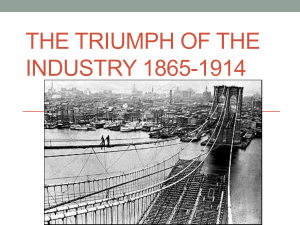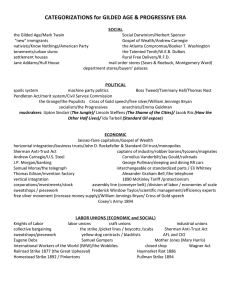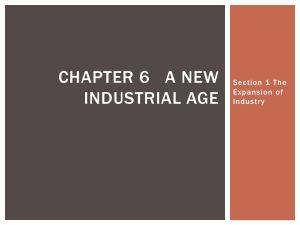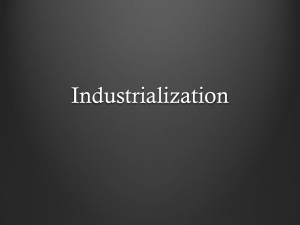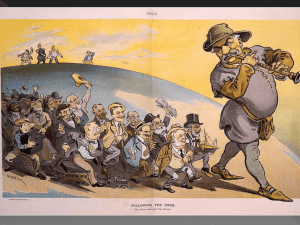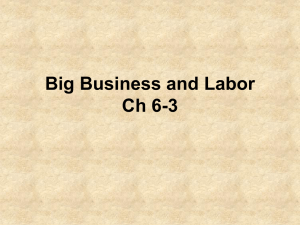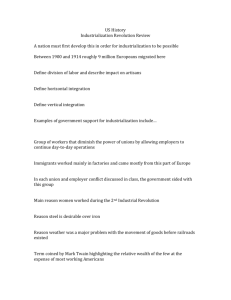Industrial Revolution Power Point
advertisement
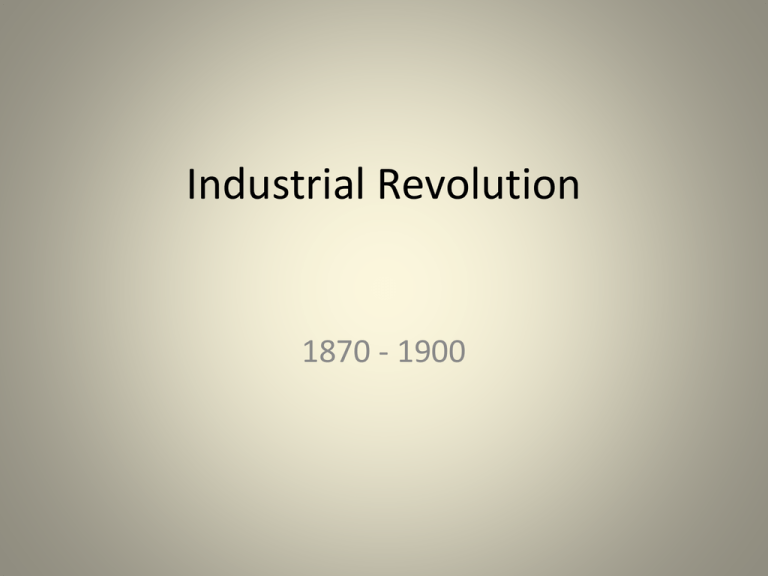
Industrial Revolution 1870 - 1900 Industrial Revolution • In the year 1800, 90% or more of the Am. population made money from agriculture. • People lived in the area they were born until they died (for the most part). • Families were large so the work got done. • When the sun went down, they went to bed. There was no light to work any longer. • Life in the city was much the same. 1900’s • More and more people began moving to the cities. • Immigrants were coming to America in larger numbers than ever before. • Where were the immigrants coming from? • Western Europe • Eastern Europe • Southern Europe Why Did We Industrialize? 1. We had a mobile society. 2. We had available capital. 3. We had an abundance of natural resources 4. We had government support. 5. We had an available workforce. Railroads and Industrialism • Gov’t gave miles of land to RR companies. • Rail was already all over the NE, but it expanded to the West. • Central Pacific and Union Pacific built the 1st transcontinental RR. • Because of more rail, the sale of more steel. Building the Railroads • Often dangerous work done by immigrants • Indian raids as well as back-breaking labor. • Random explosions from unstable dynamite. • Thousands were killed each year. Railroads and Time Zones • Because of the rail schedule, time was now important. • Traveling West w/ the sun allowed for “time zones”. • Business could now be done on a uniform schedule. Economic Impact of the Rail • Entire towns were built around RR stations. • Without the station, there was no economy. • Some towns got rich off of the rail while others failed. • Pullman, Illinois experienced both!! Scandals in the RR Industry • With millions of $ going to RR, scandal followed. • Despotic tycoons used their lines to bribe and extort entire towns. • Credit Mobilier scandal rocked the White House • The stock holders gave a contract to Credit to lay track at three times the actual cost-and pocketed the profits • They donated shares of stock to members of Congress. • Some RR policies led to violence – Pullman strike is example. Legislation • The Grange (farmer’s union) sought laws to force oversight of RR • The Interstate Commerce Act created a commission to do just that – oversight • However, it lacked teeth. • They could cite a company for bad policy, but really couldn’t do anything about it. • Sherman Anti-trust Act – no teeth Vertical Integration • Process by which a company controls the entire means of an industry. • For instance, buy iron ore mines, then buy steel factories, then buy railroads. • No one can stop them by holding out on supplies. Horizontal Integration • Another way to drive out competition • Buy up all competitors. • If they don’t sell, destroy them. Social Darwinism • Charles Darwin’s, “On the Origin of Species” was well-known. • Industrialists applied its principles to business. • Basically, only the strong survive. • The weaker businesses naturally will fail. • Gov’t job – Laissez-faire Economic Principles • Economists were trying to figure out how to measure this new economy. • One principle they understood was the business cycle. What goes up must come down. Boom and bust. • They also understood that the more one produced, the cheaper the cost. • This is known as economies of scale. Labor • Workers suffered very difficult working conditions. 1) Long work days (12 – 14 hrs.) 2) Dark factories – unsafe 3) Very low wages – company store 4) No job security – get hurt; get fired 5) Child Labor – less $, easily manipulated Labor • Workers tried to strike, but were rarely successful. • Unions were formed like the American Federation of Labor. Wanted more money, fewer hours. • It was only for the skilled worker. • Yellow dog contracts were used to keep the union out of the factory. • Workers went on strike in RR towns. Government Response • Anytime unions called for general strikes (work stoppage), management fought back. • Often, the federal government would be called on to act if there was violence. • Typically, the government backed big business. • Why?? Inventions • Factory system allowed for mass production. • Assembly line was an improvement to the factory system. • Dynamo (generator) allowed for electricity on job site. • Telegraph and telephone improved communication. • Edison’s light bulb was huge. Why? • Bessemer process – made iron into steel Producers and Consumers • The industrial North was aided by food stuffs coming from the midWest • In turn, the growing cities provided industry with workers and markets. • Many of these consumers were immigrants who worked for low pay. • Everyone benefited from this new economy, but some more than others Building a Business • Not everyone wanted to risk everything to get rich(er). • Corporations allowed for limited liability. • You could buy part ownership and share in the profits / losses. • Often times, corporations raised more capital by selling stocks. Robber Barons / Captains of Industry • Cornelius Vanderbilt – Transportation • Andrew Carnegie – Carnegie Steel • JP Morgan – US Steel / Financier • John D. Rockefeller – Standard Oil ELECTRICITY • Dynamo – Faraday and Henry 1831 invented the first form of electric generator that could power a factory or home. • 1876 Thomas Edison established the world’s first research lab in New Jersey – Menlo Park. • There Edison perfected the incandescent light bulb in 1880. • Later he invented an entire system for producing and distributing electricity. Power Plant? • By 1890, electricity powered numerous machines. Importance of electricity to business & industry? Locations? Clean & Affordable? EDISON THE TYPEWRITER • Christopher Sholes invented the typewriter in 1867 • His invention forever affected office work and paperwork • It also opened many new jobs for women • 1870: Women made up less than 5% of workforce 1910: They made up 40% THE TELEPHONE • Another important invention of the late 19th century was the telephone. • Alexander Graham Bell and Thomas Watson unveiled their invention in 1876. Importance of Comm. to the success of business & ind. in the U.S. then and now? What preceded the telephone? BELL AND HIS PHONE SHERMAN ANTI-TRUST ACT • In 1890, the Sherman Anti-Trust Act made it illegal to form a monopoly (Trust) • Prosecuting companies under the Act was not easy – a business would simply reorganize into single companies to avoid prosecution • Seven of eight cases brought before the Supreme Court were thrown out. Really enforced when? Progressives? LABOR UNIONS EMERGE • As conditions for laborers worsened, workers realized they needed to organize • The first large-scale national organization of workers was the National Labor Union in 1866 • The Colored National Labor Union followed CRAFT UNIONS • Craft Unions were unions of workers in a skilled trade • Samuel Gompers led the Cigar Makers’ International Union to join with other craft unions in 1886 • Gompers became president of the American Federation of Labor (AFL) • He focused on collective bargaining to improve conditions, wages and hours INDUSTRIAL UNIONISM • Some unions were formed with workers within a specific industry • Eugene Debs attempted this Industrial Union with the railway workers • In 1894, the new union won a strike for higher wages and at its peak had 150,000 members EUGENE DEBS
